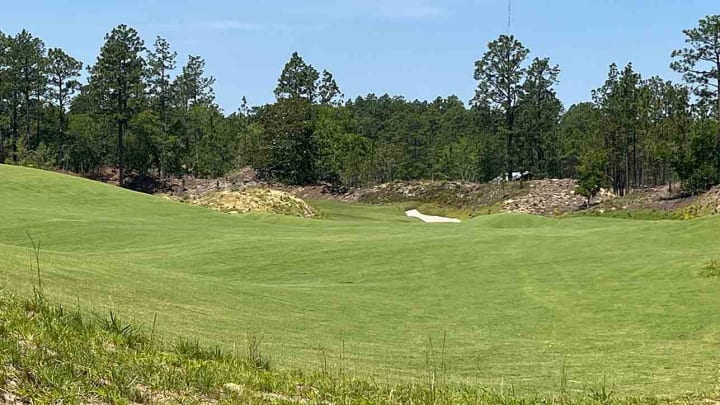Where We're Playing: Inside Pinehurst's Newest Must-Play, No. 10

PINEHURST, N.C. — For more than 100 years, ever since Boston businessman James Tufts journeyed to this scenic area in the North Carolina sandhills to build a massive hotel, then hired Donald Ross to design its signature golf layout, Pinehurst Resort has set the standard for public resort golf.
Ross’s master design, humbly called Pinehurst No. 2, hosted the 2024 U.S. Open, its fourth national championship with more to come.
But Pinehurst's latest public golf facility, with an equally humble name of Pinehurst No. 10, could one day turn out to be the most spectacular and interesting to play of all the resort's layouts.
More of SI's Golf's “Where We're Playing”: Iyopawa Island | Superstition Mountain | We-Ko-Pa | Pinehurst No. 1 | Turnberry Isle
No. 10, which opened in April and is designed by Tom Doak, is unlike anything else at Pinehurst Resort. It’s a rollicking, rolling golf ride taking players over hills, humps and bumps, just four miles from the main resort.
There is spectacular scenery, intriguing green complexes and hole routings, water and sand and trees, and, like many great layouts, just too many great holes to pick out one or two (which is also one of the few criticisms of No. 2).
“No. 10 starts out fairly gentle, then it gets into the old quarry work and it gets downright crazy, then the course gets up the hill and there's a beautiful sweeping view,” Doak said at the course opening.
Perhaps the best sign on the course sits on the par-5 10th tee box, reading "Rest and Be Thankful."
Indeed. Thankful that the so-called Capital of American Golf has opened its first new course in nearly 30 years and it’s this good and fun to play.
If there is a signature series of holes, it's 8-9-10.
After a short and dangerous par-3—a continuing theme here—the par-4 8th hole forces you to hit over a huge mound just to the right of the tee, termed the Matterhorn, to a blind fairway. Depending on where your drive lands, that’s where the fun really starts.
The green is tucked to the left behind another large mound with a green that slopes off the back. Provided where you make it on the putting surface, the green rolls downhill to the flag, which can make putting an adventure.
Even from the back tees the hole only measures 385 yards, but it can test your creativity the way most good layouts do, giving you many different options to attack the hole.
The par-4 9th is back to what’s called the Big Reveal, a chance to look into the valley where most of the back nine is set. You tee off from an elevated tee box in front of the halfway house to a dogleg-left fairway bordered by trees on both sides. There are more large bunkers to avoid with the signature wire grass all along the right side of the fairway.
The walk from the 9th green to the 10th tee is straight uphill and when you see the metal sign to rest and be thankful, you’ll know why. Behind you is a huge valley containing a massive par-5 with incredible views.
It’s 634 yards from the back tees, yet most golfers can play it as much as 100 yards shorter without diminishing the drama. The walk from the tee to the fairway is downhill, but you can see the entire hole from most second shots.
The par-3 11th is another dangerously short test with the par-5 12th the shortest two- or three-shot hole on the course, allowing you to catch your breath with a downhill walk from the fairway to the green.
The par-3 14th is the longest on the course and plays at 200 yards from most of the tee boxes. But it’s downhill and again offers great views of the landscape from the elevated teeing area.
The par-4 15th has more great views with a carry over a large lake, moving right to left. Hole 17 is the last par 3 on the course and offers more fun danger, hitting over the lake to the green with a the putting surface dramatically rolling from back to front. Any balls landing past a front pin can roll to the hole for a realistic chance of a birdie or even an ace.
The closing par 4 offers trees and wire grass on both sides, but also the greatest compliment any course can receive: asking yourself while walking to the green when you can book another tee time here.
The Doak-designed No. 10 has opened as walking-only, and with lots of elevation changes in a big footprint, 7,000 yards from the back tee, it can be a tough walk especially in warm North Carolina summers.
For a course that has only been open for a couple of months, it’s already one of the most interesting you can play at Pinehurst and will soon be crowding the medal stand with the Gil Hanse-designed No. 4, The Cradle short course and of course Ross’s timeless No. 2.
